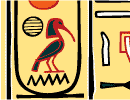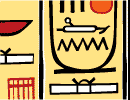|
Tombs
Although coffins and sarcophagi did a pretty good job of protecting the
mummy, the greatest safeguard against bodily damage was the tomb itself. The
most elaborate tombs are the pharaohs' pyramids, but other tombs were
underground or carved out of the sides of cliffs.
The first tombs were plain-looking flat-roofed buildings called mastabas.
They were positioned near each other like houses in a neighborhood. This
arrangement was a "city of the dead," or necropolis. Then, someone got the idea
to stack a smaller mastaba on top of a larger one, and then an even smaller one
on top of that. This was called a step pyramid and it eventually inspired the
construction of the bent pyramid and the traditional perfectly geometrical
pyramids like those belonging to Khufu, Khafre, and Menkaure. Even the Nubians
to the south liked pyramids, in fact there were more pyramids in Nubia than in
Egypt! Nubian pyramids were smaller and more pointed than Egyptian pyramids.
 |
Left to right: mastaba, step pyramid,
bent pyramid, perfectly geometrical pyramid, Nubian
pyramid |
Even though a big pyramid was a pretty impressive grave marker, they also
attracted tomb robbers by being so obvious. They were almost like giant
billboards that said "Hey tomb robbers, there is an important rich person buried
here and they have lots of gold with them inside." Then the tomb robbers would
break in shortly after burial and steal all the goods left for the mummy.
Later on, the Egyptians decided to stop making pyramids and instead carved
their pharaohs' tombs in the sides of the cliffs in an area of southern (Upper)
Egypt called The Valley of the Kings. It was very difficult to get to these
secret places so it was hoped that the mummies would be safe from tomb
robbers.
What went into the tomb?
A person's favorite possessions would be placed with them in the tomb to let
the mummy be prepared for the afterlife. King Tut must have really enjoyed his
afterlife-- he was set up with hunting weapons, senet game boards, make-up,
food, statues, sandals, clothes, models of boats, and lots more!
    
    
Some items needed for the afterlife. Top row: sandals,
bronze mirror, alabaster head rest. Bottom row: faience oil jar, senet game
board, glass kohl (eye make-up) container with applicator.
|
Ancient Egyptians were agricultural people, and they believed that they
would continue farming in the afterlife. But the wealthy, who paid others
to do their work for them, didn't plan on spending their afterlives
toiling in a field! So these people had small statues called shabtis
placed in their tombs, and they believed that the shabtis would serve as
their workers in the afterlife.
In the early New Kingdom, one shabti seemed to be enough to guarantee
an easy afterlife. But by 1000 BC, Egyptians were being buried with 401
shabtis: one for each day of the year, plus 36 "boss" shabtis to keep the
rest of them working!
shabti made of faience clay
|
  |
|





